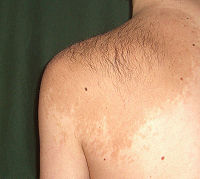Becker nevus
| Classification according to ICD-10 | |
|---|---|
| D22.9 | Melanocyte nevus, unspecified |
| ICD-10 online (WHO version 2019) | |
A Becker nevus is a single, large, irregularly brown-colored patch of skin ( hyperpigmentation ) that is densely hairy from puberty ( hypertrichosis ).
It is a particular subtype of benign pigmented limited abnormalities of the skin ( pigmented nevi ), commonly known as " moles " or " liver spots ".
Synonyms are: Becker melanosis; epidermal hairy pigmented nevus; Latin melanosis naeviformis ; English Becker's pigmentary hamartoma; Nevoid melanosis
The Becker nevus is named after Samuel William Becker , who first described it in 1948.
Epidemiology
There is comparatively little scientific work on the Becker nevus. It can therefore be assumed that this entity has not yet been conclusively researched in terms of frequency and course. It mainly affects men. The first signs of skin changes usually begin before puberty or in the course of adolescence .
The largest study on the subject is a 1981 study that screened 20,000 young French people. In this study, the prevalence was 0.52%. In half of the patients, Becker's nevus appeared in the first decade of life, in the other half between 11 and 20 years of age. The fact that only 32% of Becker nevi occurred above the nipples was also noticeable in the context of this study. This result contradicted the previous view that Becker nevi mainly occurred in the area of the chest and shoulders.
clinic
Typically, a palm-sized, sharp and jagged, irregularly hyperpigmented single lesion forms in the area of the back or shoulders. Initially, the skin changes are still smooth or slightly roughened, but after a year at the latest, increased hair growth occurs.
In contrast to the nevus cell nevi , there are no nevus cell nests or increased melanocytes , but only an increased formation of melanin as the cause of the hyperpigmentation.
Course and prognosis
A Becker nevus usually occurs spontaneously, before puberty usually as a hairless golden brown to light brown, occasionally blotchy color of the skin. A Becker nevus seldom turns pale later. Increased hair growth only occurs after pigmentation has been completed in pubertal and post-pubertal patients.
Except for visual aspects, Becker nevus is always harmless and does not pose a risk for the development of melanoma . However, it must be differentiated from a potentially dangerous connatal nevus cell , which, unlike Becker nevus, is usually present at birth. However, there are also case reports in the literature of congenital Becker nevi (created at birth). A final differential diagnosis can therefore only be made by a dermatologist or dematohistopathologist .
treatment
Different types of laser treatments can help reduce or eliminate hyperpigmentation. However, this should only be done after an assessment by the dermatologist, as other, less harmless pigment changes can imitate the appearance of a Becker nevus. The successes of treatment in both hair and pigment removal are very different, so that no general statements can be made about this.
literature
- Thomas B. Fitzpatrick, Klaus Wolff (Hrsg.): Atlas and synopsis of clinical dermatology. Common and threatening diseases. 3. Edition. McGraw-Hill, New York / Frankfurt am Main 1998, ISBN 0-07-709988-5 .
- Ernst G. Jung, Ingrid Moll (Ed.): Dermatology. 5th edition. Thieme, Stuttgart 2003, ISBN 3-13-126685-6 .
Web links
- Becker Nevus Syndrome. In: Online Mendelian Inheritance in Man . (English)
Individual evidence
- ↑ Ronald P. Rapini, Jean L. Bolognia, Joseph L. Jorizzo: Dermatology. Volume 2. Mosby, St. Louis 2007
- ↑ Becker nevus syndrome. In: Orphanet (Rare Disease Database).
- ↑ Martino Ruggieri, Ignacio Pascual-Castroviejo, Concezio Rocco (eds.): Neurocutaneous Disorders: Phakomatoses and Hamartoneoplastic Syndromes. Springer, Vienna 2008, ISBN 978-3-211-21396-4 , p. 589 ( Google books ).
- ↑ R. Tymen, JF Forestier, B. Boutet, D. Colomb: Late Becker's nevus. One hundred cases. In: Annales de Dermatologie et de Vénéréologie . Volume 108, Issue 1, 1981
- ^ SE Book, AT Glass, TA Laude: Congenital Becker's nevus with a familial association. In: Pediatric Dermatology . 14, 5, 1997, pp. 373-375, PMID 9336809
